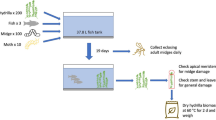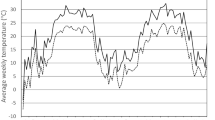Abstract
The predatory mirid Dicyphus hesperus Knight (Hemiptera: Miridae) is native to North America. The species has been used for the control of glasshouse whitefly on aubergine in the Netherlands, and is currently being evaluated for continued and wider release in Europe. Field and laboratory studies were conducted on a population collected from southern California, USA, to assess the cold tolerance and potential for outdoor establishment under prevailing northern European climates. The supercooling points (whole animal freezing temperatures) of nymphal and adult insects were around −20°C. The lethal temperatures (LTemp50) of non-diapausing nymphs and adults and diapausing adults were close to their respective freezing temperatures at −17.6, −17.6 and −19.2°C. At 5°C, the LTime50 was 54, 101.7 and 117.5 days for fed nymphs, non-diapausing and diapausing adults respectively. When first instar nymphs were placed in the field in winter, starved samples died out after 70 days, but 5% of the fed nymphs survived until the end of winter (140 days) and developed to adult on return to the laboratory. After a similar 5-month field exposure, 50% of fed diapausing adults and 15% of fed non-diapausing adults were still alive at the end of winter, whereas starved diapausing adults died after 140 days. On return to the laboratory after 5 months in the field, both diapausing and non-diapausing adults mated and laid eggs, forming viable populations. Overall, the field and laboratory experiments indicate that this population of D. hesperus is able to enter diapause and that winter temperatures are not a barrier to establishment in northern Europe.



Similar content being viewed by others
References
Babendreier D, Bigler F, Kuhlmann U (2006) Current status and constraints in the assessment of non-target effects. In: Bigler F, Babendreier D, Kuhlmann U (eds) Environmental impact of invertebrates for biological control of arthropods. Methods and risk assessment. CABI publishing, Wallingford, UK
Bale JS (2005) Effects of temperature on the establishment of non-native biocontrol agents: the predictive power of laboratory data. In Hoddle MS (Compiler) Proceedings of the second international symposium on biological control of arthropods, vol. 2, USDA Forest Service, pp 593–602
De Clercq P (2002) Dark clouds and their silver linings: exotic generalist predators in augmentative biological control. Neotrop Entomol 31:169–176
Denlinger DL (1991) Relationships between cold hardiness and diapause. In Lee RE, Denlinger DL (eds) Insects at low temperature. Chapman and Hall
Finney DJ (1971) Probit analysis. University Press, Cambridge
Gabarra R, Castane C, Bordas E, Albajes R (1988) Dicyphus tamaninii as a beneficial insect and pest in tomato crops in Catalonia, Spain. Entomophaga 33:219–228
Gillespie DR, Sanchez JAS (2004) Cumulative temperature requirements and development thresholds in two populations of Dicyphus hesperus. (Hemiptera: Miridae). Can Entomol 136:675–683
Gillespie DR, Quiring DMJ (2005) Diapause induction under greenhouse conditions in two populations of Dicyphus hesperus (Hemiptera: Miridae). Biocontrol Sci Technol 15:571–583
Hart AJ, Bale JS, Tullett AG, Worland MR, Walters KFA (2002a) Effects of temperature on the establishment potential of the predatory mite Amblyseius californicus McGregor (Acari: Phytoseiidae) in the UK. J Insect Physiol 48:593–599
Hart AJ, Tullett AG, Bale JS, Walters KFA (2002b) Effects of temperature on the establishment potential in the UK of the non-native glasshouse biocontrol agent Macrolophus caliginosus. Physiol Entomol 27:112–123
Hatherly IS, Bale JS, Walters KFA, Worland MR (2004) Thermal biology of Typhlodromips montdorensis: implications for its introduction as a glasshouse biological control agent in the UK. Entomol Exp Appl 111:97–109
Hatherly IS, Bale JS, Walters KFA (2005a) UK winter egg survival in the field and laboratory diapause of Typhlodromips montdorensis. Physiol Entomol 30:87–91
Hatherly IS, Hart AJ, Tullett AG, Bale JS (2005b) Use of thermal data as a screen for the establishment potential of non-native biological control agents in the UK. BioControl 50:687–698
Jolly RJ (2000) The predatory mite Neoseiulus californicus: its potential as a biocontrol agent for the fruit tree red spider mite Panonychus ulmi in the UK. Proceedings of the 2000 Brighton Conference – Pests & Diseases 2000 1:487–490
Labbe RM, Cloutier C, Brodeur J (2006) Prey selection by Dicyphus hesperus of infected or parasitized greenhouse whitefly. Biocontrol Sci Technol 16:485–494
Laycock A, Camm E, van Laerhoven S, Gillespie D. (2006) Cannibalism in a zoophytophagous omnivore is mediated by prey availability and plant substrate. J Insect Behav 19:219–229
Loomans AJM (2007) Regulation of invertebrate biological control agents in Europe: review and recommendations in its pursuit of a harmonised regulatory system. Report EU project REBECA [Regulation of Biological Control Agents]
McGregor RR, Gillespie DR (2005) Intraguild predation by the generalist predator Dicyphus hesperus on the parasitoid Encarsia formosa. Biocontrol Sci Technol 15:219–227
McGregor RR, Gillespie DR, Quiring DMJ, Foisy MRJ (1999) Potential use of Dicyphus hesperus Knight (Heteroptera: Miridae) for biological control of pests of greenhouse tomatoes. Biol Control 16:104–110
Sampson AC, Jacobson RJ (1999) Macrolophus caliginosus Wagner (Heteroptera: Miridae): a predator causing damage to UK tomatoes. IOBC Bull 22:213–216
Shipp JL, Wang K (2006) Evaluation of Dicyphus hersperus (Heteroptera: Miridae) for biological control of Frankliniella occidentalis (Thysanoptera: Thripidae) on greenhouse tomato. J Econ Entomol 99:414–420
Slachta M, Vambera J, Zahradnickova H Kostal V (2002) Entering diapause is a prerequisite for successful cold-acclimation in adult Graphosoma lineatum (Heteroptera: Pentatomidae). J Insect Physiol 48:1031–1039
Tullett AG, Hart AJ, Worland MR, Bale JS (2004) Assessing the effects of low temperature on the establishment potential in Britain of the non-native biological control agent Eretmocerus eremicus. Physiol Entomol 29:363–371
van Lenteren JC (1997) Benefits and risks of introducing exotic macro-biological control agents into Europe. Bull OEPP/EPPO 27:15–27
van Lenteren JC, Loomans AJM (2006) Environmental risk assessment: methods for comprehensive evaluation and quick scan. In: Bigler F, Babendreier D, Kuhlmann U (eds) Environmental impact of invertebrates for biological control of arthropods. Methods and risk assessment. CABI Publishing, Wallingford, UK
Acknowledgements
We are grateful to Jenny Dryden for technical support. The study was funded by the Dutch Horticultural Product Board and Koppert, The Netherlands.
Author information
Authors and Affiliations
Corresponding author
Rights and permissions
About this article
Cite this article
Hatherly, I.S., Pedersen, B.P. & Bale, J.S. Establishment potential of the predatory mirid Dicyphus hesperus in northern Europe. BioControl 53, 589–601 (2008). https://doi.org/10.1007/s10526-007-9099-8
Received:
Accepted:
Published:
Issue Date:
DOI: https://doi.org/10.1007/s10526-007-9099-8




